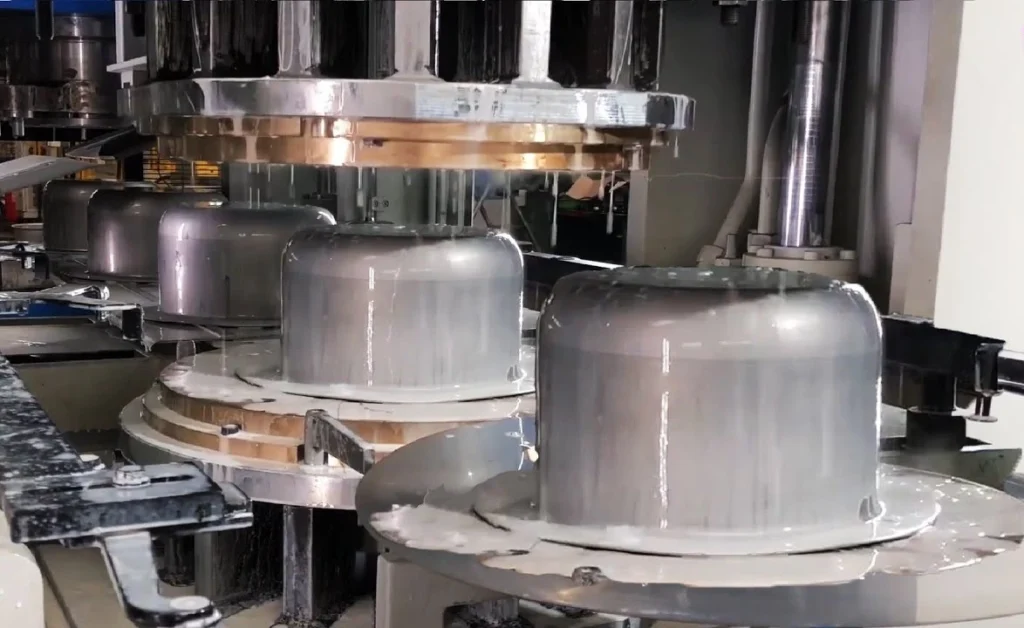
The cookware production line defines the complete manufacturing process of a cooking pan, a saucepan, a set of cooking pots, a cookware frying pan, or all cookware sets we used to have in our kitchens.
The production of cookware involves a series of interconnected processes that transform raw materials into finished products. These processes are typically divided into several stages, from material preparation to forming and shaping, coating, curing, finishing, quality control, and packaging.
Material Preparation:
- Metal Selection: The type of metal used for cookware plays a significant role in its performance and durability. Common metals include stainless steel, aluminum, copper, and cast iron.
- Metal Shaping: Raw metal sheets or strips are initially cut, shaped, and formed into basic shapes using CNC machines.
- Surface Cleaning: The metal surfaces are thoroughly cleaned to remove impurities and contaminants.
- Surface Pre-Treatment: Pre-treatment processes enhance coating adhesion, such as etching, sanding, and priming.
Forming and Shaping:
- Pressing: Hydraulic or mechanical presses form metal into final shapes.
- Deep Drawing: Complex, three-dimensional shapes, such as pot bodies and lids, are created using deep drawing.
- Spinning: Cylindrical shapes, like saucepans and bowls, are formed using a rotating mandrel.
- Trimming: Excess metal is trimmed using shearing machines or laser cutters.
- Deburring: Sharp edges are removed for safety and aesthetics.
- Polishing: Smooth, reflective finishes enhance durability and resistance to staining and corrosion.
- Embossing: Decorative patterns or textures are added for aesthetic appeal and heat distribution.
Coating:
- Enamel: Porcelain-like coatings are heat-resistant and easy to clean.
- Teflon: Nonstick coating prevents food sticking and simplifies cleanup.
- Ceramic: Durable, scratch-resistant coating provides even heat distribution.
Curing and Finishing:
- Curing: Coatings are hardened through heat treatment or chemical processes.
- Finishing: Surfaces are polished, sanded, or buffed for optimal appearance.
Quality Control:
- Inspection: Throughout production, products are inspected for dimensions, surface finish, coating integrity, and functionality.
- Testing: Specialized testing evaluates product performance, such as heat retention and durability.
Packaging:
- Protective Packaging: Cookware is carefully packaged to prevent damage during transportation and storage.
- Labeling: Labels provide essential product information and safety instructions.
Shipping:
- Distribution: Cookware is shipped to distributors, retailers, or directly to customers.
Safety Considerations:
- Machine Safety: Guards, interlocks, and safety procedures protect workers from hazards.
- Material Safety: Raw materials, solvents, and coatings are handled and stored safely.
- Fire Prevention: Fire extinguishers and emergency plans minimize fire risks.
- Ergonomic Considerations: Workstations and tasks promote safety and prevent injuries.
- Noise Control: Noise-reducing measures protect workers from excessive noise exposure.
With today’s technology, the cookware production lines are mostly automized with deep drawing presses, edge cutting trimming curling and flagging or crimping machines, inside and outside polishing machines, and automatic assembly lines to assemble the handles to the pots and pans.
Except for the Aluminum cookware set and die-cast cooking pots and pans, most of today’s all cookware importers and manufacturers prefer stainless steel as its ease of manufacturing, transport, and hygiene in usage.
Cookware Production Line
A cookware production line is a series of interconnected machines and processes that transform raw materials into finished cookware products. It typically involves several stages, from material preparation to shaping, forming, coating, and finishing. The specific steps and technologies employed may vary depending on the type of cookware being produced and the desired characteristics.
Key Stages of a Cookware Production Line
- Material Preparation:
- Metal Shaping: Raw metal sheets or strips are cut, shaped, and formed into the basic shapes of cookware components, such as pot bodies, handles, and lids.
- Surface Cleaning: The metal surfaces are thoroughly cleaned to remove any impurities or contaminants that could affect the coating adhesion or product quality.
- Forming and Shaping:
- Pressing: The metal components are pressed into their final shapes using hydraulic or mechanical presses. This process ensures consistent dimensions and forms for each cookware piece.
- Trimming: Excess metal is trimmed from the edges to create clean and precise contours for the cookware.
- Coating Application:
- Pre-Treatment: The metal surfaces undergo pre-treatment processes, such as etching or sanding, to enhance the bonding between the metal and the coating.
- Coating Application: Various coating methods, such as spray coating, dipping, or electrostatic powder coating, are employed to apply the desired coating material, such as enamel, Teflon, or ceramic, to the cookware surfaces.
- Curing and Finishing:
- Curing: The coated cookware pieces undergo a curing process, typically involving heat treatment, to allow the coating to adhere properly and achieve its desired properties.
- Finishing: The finished cookware is subjected to finishing processes, such as polishing, buffing, or sandblasting, to achieve the desired surface texture and aesthetic appearance.
- Quality Control:
- Inspection: Throughout the production line, rigorous quality control checks are conducted to ensure that the cookware meets the specified standards for dimensions, surface finish, coating integrity, and overall functionality.
- Packaging and Shipping:
- Packaging: The finished cookware is carefully packaged to protect it from damage during transportation and storage.
- Shipping: The packaged cookware is shipped to distributors, retailers, or directly to customers.
Safety Considerations in a Cookware Production Line
- Machine Safety: Proper guards, interlocks, and safety procedures must be in place to protect workers from hazards such as pinch points, moving parts, and electrical risks.
- Material Safety: Proper handling and storage of raw materials, such as chemicals, solvents, and coatings, are essential to prevent exposure and potential hazards.
- Fire Safety: Proper fire prevention and control measures, including fire extinguishers and emergency evacuation plans, are crucial to minimize fire risks.
- Ergonomic Considerations: Workstations and tasks should be designed to minimize physical strain and prevent repetitive motion injuries.
- Noise Control: Proper noise control measures, such as ear protection and noise-reducing equipment, should be implemented to protect workers from excessive noise levels.
Material Preparation
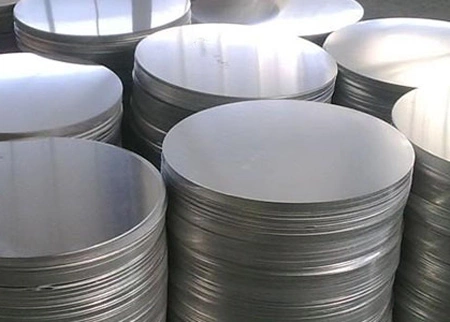
Material preparation is a crucial stage in the cookware production line, as it sets the foundation for the quality and consistency of the finished products. This stage involves several steps, from metal selection and shaping to surface cleaning and pre-treatment.
Metal Selection:
The type of metal used for cookware plays a significant role in its performance and durability. Common metals used for cookware include:
- Stainless Steel: Stainless steel is a popular choice due to its corrosion resistance, ease of cleaning, and ability to withstand high temperatures.
- Aluminium: Aluminium is lightweight and conducts heat efficiently, making it suitable for cookware that requires fast heating and cooling.
- Copper: Copper is a good conductor of heat and enhances the flavor of food, but it requires special care to prevent oxidation.
- Cast Iron: Cast iron is known for its exceptional heat retention and durability, making it suitable for long-simmering dishes.
Metal Shaping:
The raw metal sheets or strips are initially cut, shaped, and formed into the basic shapes of cookware components, such as pot bodies, handles, and lids. This process is typically done using CNC (computer numerical control) machines, which ensure precise dimensions and consistent shapes for each cookware piece.
Surface Cleaning:
Thorough cleaning of the metal surfaces is essential to remove any impurities or contaminants that could affect the coating adhesion or product quality. This process typically involves degreasing, sandblasting, or chemical cleaning to create a clean and smooth surface for coating application.
Surface Pre-Treatment:
Before coating, the metal surfaces undergo pre-treatment processes to enhance the bonding between the metal and the coating material. Common pre-treatment methods include:
- Etching: A chemical etching process creates microscopic pores on the metal surface, improving coating adhesion.
- Sanding: Light sanding removes any remaining imperfections and provides a smoother surface for coating.
- Primer Application: A primer layer is applied to the metal surface, filling in any voids and providing a base for the topcoat.
Forming and Shaping
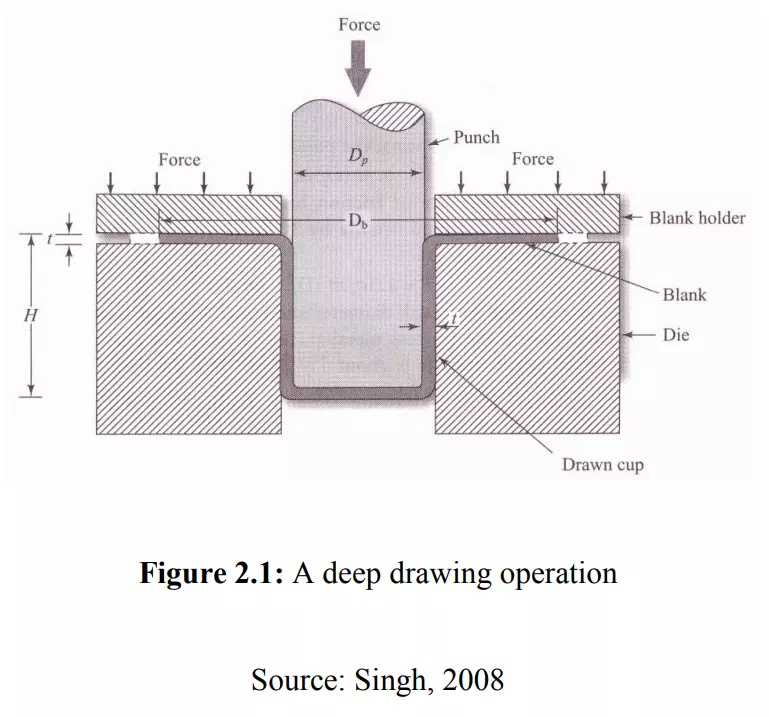
After material preparation, the cookware components undergo a series of forming and shaping processes to achieve the desired final shapes and dimensions. These processes are crucial for ensuring the functionality, durability, and aesthetics of the cookware.
Pressing:
Hydraulic or mechanical presses are employed to form the metal components into their final shapes. The pressing process applies uniform pressure to the metal, causing it to deform and conform to the desired contours. This method ensures consistent dimensions and shapes for each cookware piece.
Deep Drawing:
Deep drawing is a specialized forming process used to create complex, three-dimensional shapes, such as pot bodies and lids. The metal is gradually drawn into a die using a punch, shaping it into the desired form without thinning or warping the material.
Spinning:
Spinning is a process that utilizes a rotating mandrel to form metal into cylindrical shapes, such as saucepans and bowls. The metal is gradually pressed against the mandrel by a spinning tool, conforming to its shape and creating a smooth, seamless finish.
Trimming:
After forming, excess metal is trimmed from the edges of the cookware components using shearing machines or laser cutters. This process ensures clean and precise contours for the cookware, removing any irregularities or imperfections.
Deburring:
Deburring removes any sharp edges or burrs that may have formed during the forming or trimming processes. This step is essential to prevent injuries and ensure a smooth, finished appearance.
Polishing:
Polishing is used to enhance the surface finish of cookware, making it more resistant to staining and corrosion. This process involves rubbing the surface with abrasive compounds or using buffing tools to achieve a smooth, reflective finish.
Embossing:
Embossing adds decorative patterns or textures to the cookware surface, providing aesthetic appeal and enhancing heat distribution. This process involves stamping or pressing the desired pattern onto the metal using specialized dies.
Through these forming and shaping techniques, cookware manufacturers achieve the desired shapes, dimensions, and surface finishes that are essential for their products’ functionality, durability, and visual appeal.
Coating Application
Coating application plays a crucial role in cookware production, providing both functional and aesthetic benefits. The type of coating used significantly impacts the performance and durability of the cookware, influencing its ability to cook food evenly, prevent sticking, resist staining and corrosion, and enhance the overall appearance.
Common Coating Types for Cookware
- Enamel: Enamel coatings are porcelain-like finishes that are fused onto the cookware surface. They are known for their exceptional heat resistance, durability, and easy-to-clean properties. Enamel coatings are often used on cast iron cookware, enhancing its heat retention and providing a smooth, non-porous surface.
- Teflon: Teflon, also known as polytetrafluoroethylene (PTFE), is a nonstick coating that prevents food from sticking to the cookware surface. It is characterized by its low surface friction, allowing food to slide effortlessly, making cleanup a breeze. Teflon coatings are commonly used on aluminum and stainless steel cookware, enhancing their versatility and ease of use.
- Ceramic: Ceramic coatings are durable, scratch-resistant finishes that are applied to the cookware surface. They are known for their ability to withstand high temperatures, providing even heat distribution and preventing hot spots. Ceramic coatings are often used on nonstick cookware, offering a more durable and scratch-resistant alternative to Teflon.
Coating Application Methods
- Spray Coating: Spray coating involves applying a liquid coating material to the cookware surface using a spray gun. This method provides uniform coverage and is suitable for complex shapes.
- Dipping: Dipping involves immersing the cookware in a tank of liquid coating material, ensuring complete coverage of the surfaces. This method is efficient for high-volume production.
- Electrostatic Powder Coating: Electrostatic powder coating involves spraying dry, powdered coating particles onto the cookware surface using an electrostatic charge. The charged particles adhere to the cookware, creating a uniform and durable coating.
Factors Affecting Coating Performance
- Metal Surface Preparation: Proper surface preparation, including cleaning, etching, and priming, ensures a strong bond between the coating and the metal surface, enhancing coating adhesion and durability.
- Coating Material Properties: The composition and properties of the coating material significantly impact its performance characteristics, such as nonstick properties, heat resistance, scratch
What Material for Cookware is the Best
The best material for cookware depends on your individual needs and preferences. Here is a comparison of the most common cookware materials to help you decide which one is right for you:
| Material | Pros | Cons |
|---|---|---|
| Stainless steel | Durable, easy to clean, suitable for all cooking methods | Can be reactive with acidic foods, not as good at heat retention as cast iron |
| Aluminum | Lightweight, conducts heat well, affordable | Can be scratched easily, not as durable as stainless steel |
| Cast iron | Excellent heat retention, durable, versatile for all cooking methods | Requires seasoning, can be heavy |
| Copper | Conducts heat the best, even heat distribution, beautiful appearance | Expensive, requires polishing, can react with acidic foods |
| Ceramic | Nonstick, scratch-resistant, easy to clean | Not as durable as other materials, can be expensive |
Stainless steel is a versatile and durable option that is suitable for all cooking methods. It is easy to clean and does not react with most foods. However, stainless steel can be reactive with acidic foods, and it is not as good at heat retention as cast iron.
Aluminum is a lightweight and affordable option that conducts heat well. This makes it a good choice for cookware that you will use for quick-cooking methods, such as sautéing and stir-frying. However, aluminum can be scratched easily, and it is not as durable as stainless steel.
Cast iron is known for its exceptional heat retention and durability. It is also versatile and can be used for all cooking methods. However, cast iron requires seasoning to prevent rust, and it can be heavy.
Copper is the best conductor of heat, and it provides even heat distribution. This makes it a good choice for cookware that you will use for delicate cooking methods, such as making sauces and reductions. However, copper is expensive, and it requires polishing to maintain its appearance.
Ceramic is a nonstick and scratch-resistant option that is easy to clean. It is a good choice for cookware that you will use for cooking delicate foods, such as fish and eggs. However, ceramic is not as durable as other materials, and it can be expensive.
Ultimately, the best way to choose the best material for cookware is to try out a few different types and see what you like best.
Stainless steel is thought to be the best material for cookware manufacturing because of its chemical properties that allow not to react with acidic and alkaline foods. But in terms of cooking easiness, Cast iron has better thermal conduction that shortens the heating time. The most preferred stainless steel type is 18/10 (the ratio of chromium to nickel added).
People used to use copper pots and pans in the past as it is the best heat conductor available. But during the heating process, the copper can give a metallic taste to the food as it reacts with acidic foods and natural minerals. That’s why people used tin or stainless steel to cover the copper cookware with a thin layer.
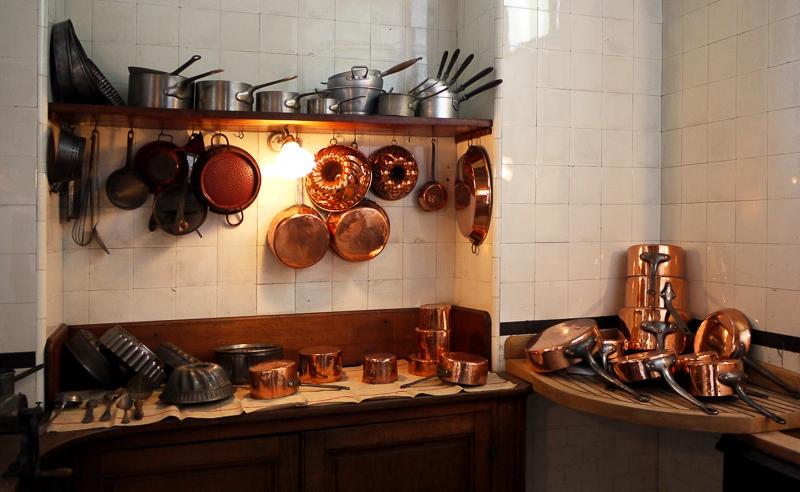
Nonstick cookware is getting more and more popular in the market. Cooking non-stick is a special coating applied on the metal pots and pans in order to form a barrier between the cookware metal and the food. This coating layer also provides a longer life for the cookware as the stretches and damages are also avoided with the help of the non-stick coating layer.
Cookware Production Line
The cookware production line consists of the following machinery:
- Sheet Metal Decoiler
- Sheet Metal Press Feeding Line
- Eccentric Press for Circle Blanking
- Deep Drawing Press for the Drawing of the Pots or Pans
- Edge Cutting and Trimming of the Pots or Pans
- Edge Curling of the Cookware
- Handle Riveting to the Cookware
A cookware production line involves a series of interconnected machines and processes that transform raw materials into finished cookware products. These processes typically involve several stages, from material preparation to shaping, forming, coating, and finishing. Let’s delve into the specific machines and processes involved in cookware production:
- Sheet Metal Decoiler: The journey begins with a sheet metal decoiler, which unwinds the raw metal sheets from a coil or roll. The decoiler ensures smooth and controlled unwinding of the material, preventing tangles or creases that could affect the final product quality.
- Sheet Metal Press Feeding Line: The decoiled sheet metal is then fed into the sheet metal press feeding line, which consists of a series of rollers and guides. This feeding line precisely positions the sheet metal strip in front of the press, ensuring accurate alignment for blanking and forming operations.
- Eccentric Press for Circle Blanking: An eccentric press is employed to cut circular blanks from the sheet metal strip. This press utilizes a rotating eccentric mechanism to deliver precise and powerful strokes, resulting in clean and uniform blanks.
- Deep Drawing Press for the Drawing of the Pots or Pans: The circular blanks are then transferred to a deep drawing press, which shapes the blanks into the desired pot or pan forms. This process involves gradually drawing the metal into a die, forming the contours of the cookware without thinning or warping the material.
- Edge Cutting and Trimming of the Pots or Pans: After deep drawing, the excess metal around the edges of the pots or pans is trimmed using shearing machines or laser cutters. This process ensures clean and precise contours for the cookware, removing any irregularities or imperfections.
- Edge Curling of the Cookware: To enhance the aesthetics and functionality of the cookware, an edge curling machine is used to create curled edges. This process involves gradually rolling the edges of the pots or pans, creating a smooth, rounded finish that prevents sharp edges and adds a touch of elegance.
- Handle Riveting to the Cookware: The final step involves attaching handles to the cookware using riveting machines. These machines precisely position the handle components and insert rivets, securely fastening the handles to the cookware bodies.
The specific machines and processes employed in a cookware production line may vary depending on the type of cookware being produced and the desired characteristics. However, the general sequence of operations remains consistent, ensuring the transformation of raw materials into high-quality cookware products.
Sheet Metal Decoiler for the Cookware Production Line
Sheet metal decoiler is equipment that decoils the sheet metal from a coil. The decoiler moves in both directions in order to coil or decoil the sheet coil. A decoiler can be made as mechanical or hydraulic depending on the weight of the coil.
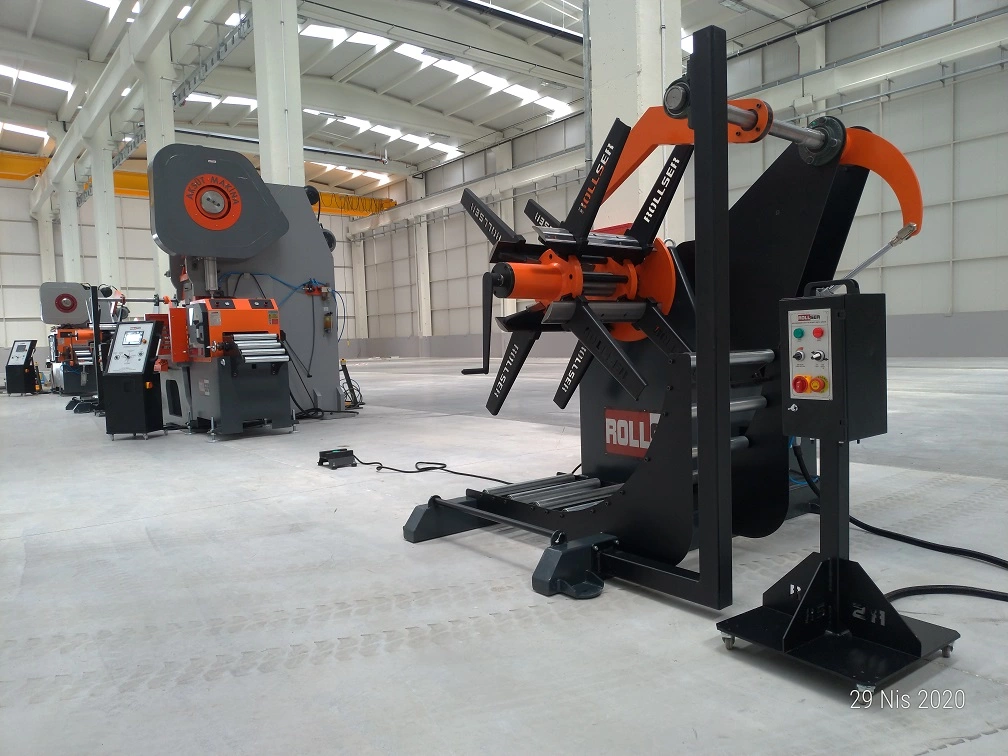
A sheet metal decoiler is a crucial component in the cookware production line, responsible for unwinding and feeding the raw metal sheets into the subsequent forming and shaping processes. It plays a vital role in ensuring a smooth and continuous supply of material, maintaining consistent production flow and minimizing downtime.
Function and Operation of a Sheet Metal Decoiler
The primary function of a sheet metal decoiler is to unwind the metal coils or rolls in a controlled manner, preventing tangles, creases, or other imperfections that could disrupt the production process. It typically consists of a series of rollers, guides, and tension control mechanisms that work together to maintain consistent tension and alignment of the metal strip.
Key Components of a Sheet Metal Decoiler
- Unwinding Mandrel: The unwinding mandrel grips the inner coil of the metal sheet, providing a secure hold while allowing controlled rotation.
- Leveling and Guiding System: A series of rollers and guides ensure that the metal strip is kept level and aligned throughout the unwinding process, preventing misalignment or edge curl.
- Tension Control System: A tension control mechanism, often involving hydraulic or pneumatic systems, maintains consistent tension on the metal strip as it unwinds. This ensures that the material is fed smoothly and without slack or excessive pulling.
- Loop Control System: A loop control system maintains a controlled loop of material between the decoiler and the subsequent press feeding line. This loop allows for minor adjustments in speed and alignment without interrupting the production flow.
Safety Considerations for Sheet Metal Decoiler Operation
- Machine Guarding: Proper guards should be installed to protect workers from entanglement hazards and moving parts, especially around the unwinding mandrel and rollers.
- Emergency Stop Buttons: Clearly marked emergency stop buttons should be readily accessible to enable workers to quickly halt the machine in case of an unsafe situation.
- Proper Training and Supervision: Workers should receive thorough training on the safe operation and maintenance of the decoiler, including lockout/tagout procedures for machine repairs.
- Personal Protective Equipment (PPE): Workers should wear appropriate PPE, such as gloves, safety glasses, and protective footwear, to minimize the risk of injuries from handling metal sheets and operating the machinery.
Conclusion
The sheet metal decoiler plays a critical role in ensuring the efficient and safe operation of the cookware production line. Its ability to unwind and feed metal sheets smoothly and consistently contributes to the production of high-quality cookware products. By adhering to strict safety guidelines and ensuring proper operator training, the decoiler can operate reliably and effectively, minimizing potential hazards and maximizing productivity.
After the decoiler, the sheet is transferred to the press by a press feeding line
Sheet Metal Press Feeding Line for the Cookware Production Line
The sheet metal press feeding line is a complex piece of equipment, that consists of a servo driver and straightener. The Servo driver is an electromechanical device, used to drive the sheet into the molds of the press at a given distance. The distance here can be as small as 1/100 of an mm. This distance depends on the precision of the servo motor used in the driver. Before the servo driver, a straightener is also used to straighten the sheet after the decoiler.
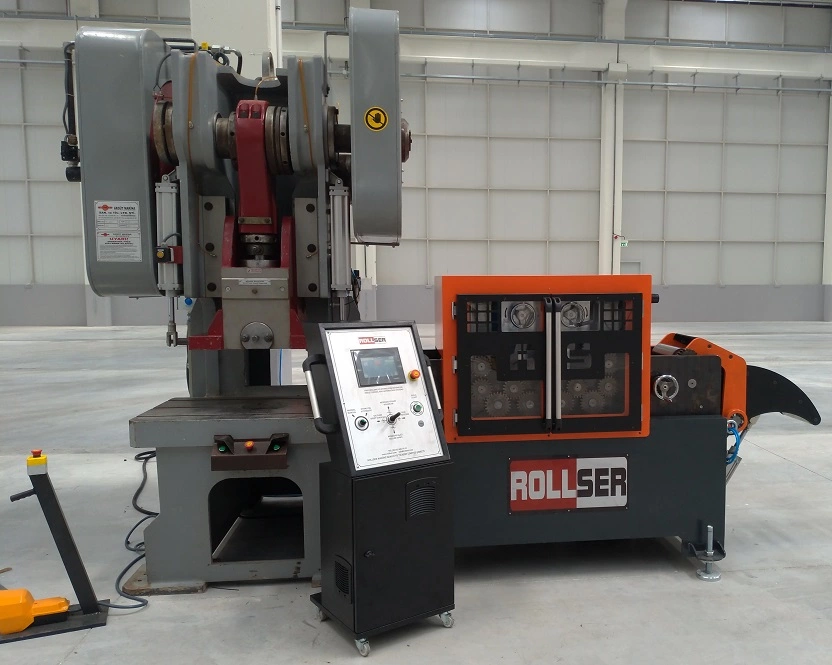
A sheet metal press feeding line is an essential component in the cookware production line, responsible for precisely positioning and feeding metal strips into the press for blanking, forming, and shaping operations. It plays a vital role in ensuring accurate alignment, consistent feeding, and efficient production flow.
Function and Operation of a Sheet Metal Press Feeding Line
The primary function of a sheet metal press feeding line is to transport and align metal strips accurately to the press for precise blanking or forming operations. It consists of a series of rollers, guides, and leveling mechanisms that work together to ensure consistent feeding and alignment of the metal strip.
Key Components of a Sheet Metal Press Feeding Line
- Entry Guides: Entry guides align the metal strip as it enters the feeding line, ensuring a straight and even path.
- Leveling Rollers: Leveling rollers remove any unevenness or curl from the metal strip, maintaining a flat surface for accurate feeding.
- Pinch Rollers: Pinch rollers grip the metal strip and feed it into the press at a controlled speed.
- Loop Control System: A loop control system maintains a controlled loop of material between the feeding line and the press. This loop allows for minor adjustments in speed and alignment without interrupting the production flow.
- Stop Mechanism: A stop mechanism precisely positions the metal strip at the desired location in front of the press.
Types of Sheet Metal Press Feeding Lines
- Roll Feeders: Roll feeders are the most common type of press feeding line, utilizing rollers to transport the metal strip. They offer simplicity, reliability, and versatility.
- Servo Feeders: Servo feeders employ servo motors to provide precise control over feeding speed and positioning. They are ideal for high-speed applications and intricate forming operations.
- Gripper Feeders: Gripper feeders use grippers to hold and transport the metal strip, offering superior control over alignment and positioning. They are particularly useful for delicate or pre-formed materials.
Safety Considerations for Sheet Metal Press Feeding Line Operation
- Machine Guarding: Proper guards should be installed to protect workers from entanglement hazards and moving parts, especially around the rollers and pinch rollers.
- Emergency Stop Buttons: Clearly marked emergency stop buttons should be readily accessible to enable workers to quickly halt the machine in case of an unsafe situation.
- Proper Training and Supervision: Workers should receive thorough training on the safe operation and maintenance of the feeding line, including lockout/tagout procedures for machine repairs.
- Personal Protective Equipment (PPE): Workers should wear appropriate PPE, such as gloves, safety glasses, and protective footwear, to minimize the risk of injuries from handling metal sheets and operating the machinery.
Conclusion
The sheet metal press feeding line plays a critical role in ensuring the efficient and safe operation of the cookware production line. Its ability to precisely position and feed metal strips contributes to the production of high-quality cookware products with consistent dimensions and shapes. By adhering to strict safety guidelines and ensuring proper operator training, the feeding line can operate reliably and effectively, minimizing potential hazards and maximizing productivity.
Eccentric Press for Circle Blanking for the Cookware Production Line
The eccentric press is also another electromechanical equipment, that cuts out the circle blanks from the sheet metal rolls for further production. The eccentric press punches out the circle blanks by pressing the cutting mold into the sheet metal. This is a serial cutting operation for the circle cutting of sheet metals. After the circle cutting operation, we get the circle discs as below:
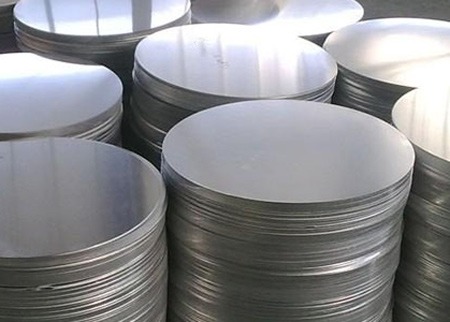
An eccentric press plays a crucial role in the cookware production line by precisely cutting circular blanks from sheet metal strips. These blanks serve as the starting point for shaping and forming various cookware pieces, such as pots, pans, and lids. The eccentric press ensures consistent dimensions, smooth edges, and minimal material waste.
Function and Operation of an Eccentric Press
The eccentric press utilizes a rotating eccentric mechanism to deliver powerful and controlled strokes, enabling precise cutting and forming operations. The metal strip is positioned between a fixed die and a movable punch. As the eccentric gear rotates, it drives the punch downwards, applying pressure to the metal strip and forcing it through the die. The resulting circular blank is then ejected from the press.
Key Components of an Eccentric Press
- Frame: The sturdy frame provides the structural support for the entire press, housing the eccentric mechanism, flywheel, and other components.
- Eccentric Gear: The eccentric gear serves as the heart of the press, converting rotational motion into powerful downward strokes.
- Flywheel: The flywheel stores energy during the upward stroke and releases it during the downward stroke, ensuring consistent and powerful cutting action.
- Clutch and Brake System: The clutch and brake system controls the engagement and disengagement of the flywheel, allowing for precise control over the cutting cycle.
- Die and Punch: The die, typically made from hardened steel, forms the desired shape in the metal strip, while the punch applies the cutting force.
- Feed Mechanism: The feed mechanism accurately positions the metal strip in front of the die and punch, ensuring consistent alignment and cutting results.
Advantages of Eccentric Presses for Circle Blanking
- Precision: Eccentric presses offer high precision, producing circular blanks with consistent dimensions and smooth edges.
- Speed: These presses operate at high speeds, enabling efficient production and minimizing cycle times.
- Versatility: Eccentric presses can handle a wide range of materials, including various grades of steel, aluminum, and copper.
- Durability: Built with robust construction, eccentric presses are designed for long-lasting performance and reliability.
Safety Considerations for Eccentric Press Operation
- Machine Guarding: Proper guards should be installed to prevent workers from accessing hazardous moving parts, such as the flywheel and punch.
- Two-Hand Controls: Two-hand controls require the operator to use both hands to initiate the cutting cycle, reducing the risk of accidental injuries.
- Emergency Stop Buttons: Clearly marked emergency stop buttons should be readily accessible to enable workers to quickly halt the machine in case of an unsafe situation.
- Proper Training and Supervision: Workers should receive thorough training on the safe operation and maintenance of the eccentric press, including lockout/tagout procedures for machine repairs.
- Personal Protective Equipment (PPE): Workers should wear appropriate PPE, such as safety glasses, gloves, and hearing protection, to minimize the risk of injuries from operating the machinery and handling metal sheets.
Conclusion
Eccentric presses are essential components in cookware production lines, providing precise and efficient circle blanking operations. Their ability to produce high-quality blanks with consistent dimensions and smooth edges sets the foundation for the subsequent forming and shaping of cookware pieces. By adhering to strict safety guidelines and ensuring proper operator training, eccentric presses can operate reliably and effectively, minimizing potential hazards and maximizing productivity.
Deep Drawing Press for the Drawing of the Pots or Pans
A deep drawing press plays a crucial role in cookware production, transforming flat circular blanks into the three-dimensional shapes of pots and pans. It employs a gradual drawing process to shape the metal without thinning or warping, ensuring the integrity and durability of the cookware.
Function and Operation of a Deep Drawing Press
The deep drawing press utilizes a combination of force and controlled deformation to transform the metal blank into the desired shape. The blank is placed over a die and held in place by a blankholder ring. As the punch descends, it gradually draws the metal into the die, forming the desired contours of the pot or pan.
Key Components of a Deep Drawing Press
- Frame: The sturdy frame provides the structural support for the entire press, housing the hydraulic system, drawing mechanism, and control components.
- Hydraulic System: The hydraulic system generates and controls the high pressure required to draw the metal into the die. It consists of hydraulic pumps, valves, cylinders, and piping that work together to provide precise and controlled pressure.
- Drawing Mechanism: The drawing mechanism consists of a punch, die, and blankholder ring. The punch applies force to the blank, drawing it into the die, while the blankholder ring prevents the blank from buckling or thinning during the process.
- Control System: The control system regulates the drawing process, ensuring precise depth, shape, and thickness control. It typically consists of a computer or programmable logic controller (PLC) that receives input from sensors and adjusts the hydraulic system accordingly.
Advantages of Deep Drawing Presses for Cookware Production
- Versatility: Deep drawing presses can handle a wide range of shapes and sizes, making them suitable for producing a variety of cookware items.
- Precision: These presses offer high precision, producing cookware with consistent dimensions and smooth surfaces.
- Efficiency: Deep drawing presses operate efficiently, minimizing production time and material waste.
- Durability: The formed cookware pieces are strong and durable due to the controlled deformation process.
Safety Considerations for Deep Drawing Press Operation
- Machine Guarding: Proper guards should be installed to prevent workers from accessing hazardous moving parts, such as the punch and blankholder ring.
- Safety Interlocks: Safety interlocks prevent the press from operating if the guards are not in place or if the safety sensors detect an unsafe condition.
- Emergency Stop Buttons: Clearly marked emergency stop buttons should be readily accessible to enable workers to quickly halt the machine in case of an unsafe situation.
- Proper Training and Supervision: Workers should receive thorough training on the safe operation and maintenance of the deep drawing press, including lockout/tagout procedures for machine repairs.
- Personal Protective Equipment (PPE): Workers should wear appropriate PPE, such as safety glasses, gloves, and hearing protection, to minimize the risk of injuries from operating the machinery and handling metal sheets.
Conclusion
Deep drawing presses are indispensable tools in cookware production lines, enabling the transformation of flat blanks into the intricate shapes of pots and pans. Their ability to produce high-quality cookware with consistent dimensions and smooth surfaces contributes significantly to the overall quality and aesthetics of the finished products. By adhering to strict safety guidelines and ensuring proper operator training, deep drawing presses can operate reliably and effectively, minimizing potential hazards and maximizing productivity.
The cookware factory companies or cookware manufacturer companies need to have these machines in comparison to cookware importer companies as the cookware importer companies usually by the pots and pans already in assembled form. The cookware pots and pans, cookware saucepan set, cookware pots and pans set, cookware pan, cookware pan set, cookware pots, cookware pot set, cookware saucepans and cookware sets pots and pans are all manufactured in this way.
The other type of cookware as die-casting cookware or die-casting nonstick cookware are the two types of cook ware products that aren’t manufactured this way.
Edge Cutting and Trimming of the Pots or Pans
The Edge cutting and trimming is the next step in a cookware production line. The cookware production line is a serial production line where each machine is the next step of the previous one.
The edge-cutting trimming and forming is a special metalworking process, designed to cut the rims of a pot or a pan after the deep-drawing operation. It is also called edge wrapping, edge beading, or edge crimping in some cases.
Edge cutting and trimming are crucial steps in the cookware production process, ensuring that pots and pans have clean, precise contours and eliminate any excess metal. These processes are typically performed using shearing machines or laser cutters, depending on the specific requirements of the cookware design.
Edge Cutting
Edge cutting involves removing the excess metal from the edges of the pot or pan, creating a smooth and uniform finish. This process ensures that the cookware has a professional appearance and prevents any sharp edges that could pose a safety hazard. Shearing machines are commonly used for edge cutting, as they can handle a variety of metal thicknesses and provide a fast and efficient process.
Trimming
Trimming involves removing small imperfections or burrs from the edges of the pot or pan. This process ensures that the cookware has a clean and polished appearance and enhances its durability. Laser cutters are often used for trimming, as they can achieve high precision and create a smooth, burr-free finish.
Benefits of Edge Cutting and Trimming
- Improved Aesthetics: Edge cutting and trimming give pots and pans a clean, professional appearance that appeals to consumers.
- Enhanced Safety: By removing sharp edges, edge cutting and trimming minimize the risk of injuries during handling or use.
- Improved Durability: Smooth, polished edges are less prone to corrosion and chipping, extending the lifespan of the cookware.
- Consistency: Edge cutting and trimming procedures ensure that pots and pans have consistent dimensions and finishes, maintaining brand quality and reducing the risk of customer complaints.
Safety Considerations for Edge Cutting and Trimming
- Machine Guarding: Proper guards should be installed to prevent workers from accessing hazardous moving parts, such as the shearing blades or laser beam.
- Emergency Stop Buttons: Clearly marked emergency stop buttons should be readily accessible to enable workers to quickly halt the machine in case of an unsafe situation.
- Proper Training and Supervision: Workers should receive thorough training on the safe operation and maintenance of the edge cutting and trimming equipment.
- Personal Protective Equipment (PPE): Workers should wear appropriate PPE, such as safety glasses, gloves, and hearing protection, to minimize the risk of injuries from operating the machinery.
Edge Curling of the Cookware
The edge curling is a special metalworking operation that forms hollow curls on the edges of round sheet metal parts.
Edge curling is a similar process to edge cutting or trimming by means of operation.
- Material Selection: Choose a sheet metal material suitable for cookware, considering factors like heat conductivity, durability, and ease of forming.
- Cutting: Begin with a flat sheet of metal, and cut it into the desired shape for the cookware using processes such as laser cutting or stamping.
- Edge Curling: The edge curling operation involves bending the edges of the sheet metal to form a lip or rim. This can be achieved through various methods, including:
- Roll Forming: The sheet metal is passed through a set of rollers that gradually bend the edges to the desired shape.
- Press Brake: A press brake with specially designed tooling is used to fold and shape the edges of the sheet metal.
- Die Forming: Dies, which are molds with the desired shape, are used to press the edges into the required form.
- Quality Check: After the edge curling operation, the formed edges are inspected for uniformity, strength, and overall quality. Any defects or inconsistencies are addressed.
- Further Processing: The cookware may undergo additional manufacturing processes, such as surface finishing, coating, or assembly, depending on the specific product requirements.
This edge curling process not only adds structural integrity to the cookware but also provides a smooth and safe edge for handling. It’s an essential step in the overall production of sheet metal cookware.
Handle Riveting to the Cookware
After the edge cutting trimming and curling, the next and final step is riveting of the handle to the pots and pans. Riveting is a mechanical joining operation that connects two parts with a rivet.
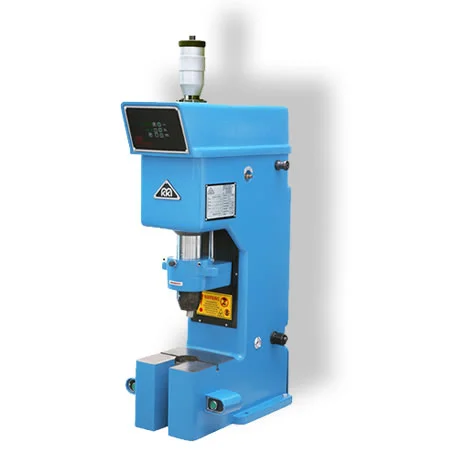
Handle riveting is a crucial step in cookware production, securely attaching handles to pots and pans to ensure functionality and durability. It involves precisely positioning and fastening rivets to create a strong and permanent bond between the handle and the cookware body.
Function and Operation of Handle Riveting
Handle riveting utilizes a mechanical process to insert and secure rivets, creating a strong and permanent joint between the handle and the cookware body. A riveting machine precisely positions the handle and cookware components, and a riveting tool forcefully inserts the rivet through the aligned holes. The rivet is then expanded on the opposite side, forming a mushroom-shaped head that securely locks the components together.
Key Components of Handle Riveting Equipment
- Riveting Machine: The riveting machine provides the mechanical force to insert and expand the rivets. It consists of a frame, a riveting head, and a control system.
- Riveting Tool: The riveting tool, typically a hammer or a hydraulic press, applies the force to insert and expand the rivet.
- Rivets: Rivets are the fasteners that secure the handle to the cookware body. They are typically made of aluminum or steel and have a cylindrical shape with a shank and a head.
- Drill or Rivet Hole Punch: A drill or rivet hole punch is used to create the holes in the handle and cookware body for the rivets to pass through.
Advantages of Handle Riveting for Cookware
- Strength and Durability: Riveting provides a strong and durable joint that can withstand high temperatures and repeated use.
- Ease of Repair: If a rivet fails, it can be easily replaced without affecting the integrity of the cookware.
- Aesthetic Appeal: Riveting can add a decorative touch to cookware, enhancing its visual appeal.
- Versatility: Riveting can be used to attach handles to a variety of cookware materials, including stainless steel, aluminum, and cast iron.
Safety Considerations for Handle Riveting Operation
- Machine Guarding: Proper guards should be installed to protect workers from hazardous moving parts, such as the riveting tool and the rivets.
- Safety Interlocks: Safety interlocks prevent the riveting machine from operating if the guards are not in place or if the safety sensors detect an unsafe condition.
- Emergency Stop Buttons: Clearly marked emergency stop buttons should be readily accessible to enable workers to quickly halt the machine in case of an unsafe situation.
- Proper Training and Supervision: Workers should receive thorough training on the safe operation and maintenance of the riveting equipment, including lockout/tagout procedures for machine repairs.
- Personal Protective Equipment (PPE): Workers should wear appropriate PPE, such as safety glasses, gloves, and hearing protection, to minimize the risk of injuries from operating the machinery and handling metal components.
Conclusion
Handle riveting plays a critical role in cookware production, ensuring that handles are securely attached and can withstand the rigors of everyday use. By adhering to strict safety guidelines and ensuring proper operator training, handle riveting can be performed efficiently and safely, contributing to the production of high-quality cookware products that are both functional and durable.
EMS Metalworking Machinery
We design, manufacture and assembly metalworking machinery such as:
- Hydraulic transfer press
- Glass mosaic press
- Hydraulic deep drawing press
- Casting press
- Hydraulic cold forming press
- Hydroforming press
- Composite press
- Silicone rubber moulding press
- Brake pad press
- Melamine press
- SMC & BMC Press
- Labrotaroy press
- Edge cutting trimming machine
- Edge curling machine
- Trimming beading machine
- Trimming joggling machine
- Cookware production line
- Pipe bending machine
- Profile bending machine
- Bandsaw for metal
- Cylindrical welding machine
- Horizontal pres and cookware
- Kitchenware, hotelware
- Bakeware and cuttlery production machinery
as a complete line as well as an individual machine such as:
- Edge cutting trimming beading machines
- Polishing and grinding machines for pot and pans
- Hydraulic drawing presses
- Circle blanking machines
- Riveting machine
- Hole punching machines
- Press feeding machine
You can check our machinery at work at: EMS Metalworking Machinery – YouTube
Applications:
- Beading and ribbing
- Flanging
- Trimming
- Curling
- Lock-seaming
- Ribbing
- Flange-punching
